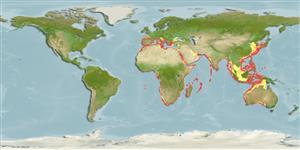Common names from other countries
Classification / Names / Names
Common names | Synonyms | Catalog of Fishes (gen., sp.) | ITIS | CoL | WoRMS
Environment: milieu / climate zone / depth range / distribution range
Ecology
Benthic; depth range 3 - 600 m (Ref. 804), usually 300 - 400 m (Ref. 804). Subtropical; 48°N - 37°S, 13°W - 139°E
Indo-West Pacific, Eastern Atlantic and the Mediterranean: eastern Atlantic from Gulf of Biscay to Congo and around the Mediterranean, and it is widely distributed throughout the coasts of Morocco.
Length at first maturity / Size / Weight / Age
Maturity: Lm ? range ? - ? cm Max length : 7.8 cm TL male/unsexed; (Ref. 804)
Minimum depth from Ref. 881.
Life cycle and mating behavior
Maturity | Reproduction | Spawning | Eggs | Fecundity | Larvae
Members of the order Decapoda are mostly gonochoric. Mating behavior: Precopulatory courtship ritual is common (through olfactory and tactile cues); usually indirect sperm transfer.
Bianchi, G., K.E. Carpenter, J.-P. Roux, F.J. Molloy, D. Boyer and H.J. Boyer. 1999. (Ref. 804)
IUCN Red List Status (Ref. 130435: Version 2024-1)
CITES status (Ref. 108899)
Not Evaluated
Not Evaluated
Human uses
| FishSource |
Tools
Internet sources
Estimates based on models
Preferred temperature
(Ref.
115969): 8.6 - 15.9, mean 11.6 (based on 245 cells).
Resilience
High, minimum population doubling time less than 15 months (K=0.4-0.48).
Vulnerability
Low to moderate vulnerability (27 of 100).
